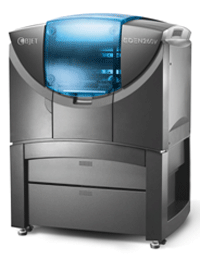A Look at Local Rapid Prototyping

Objet Eden 260V polyjet printer. Courtesy of Objet.
Latest News
April 6, 2012
I may get tired of saying this eventually, but not today. 3D printing is amazing. Prototyping is only the tip of the additive manufacturing (AM) iceberg, but it still remains an important part of the field. The ability for companies to produce their own prototypes in hours (or days, at the most) rather than weeks can’t be underestimated.
One example of how AM can change the commercial environment in local industries is seen in the use of the technology by the Lansing Economic Area Partnership (LEAP). LEAP has teamed up with Lansing Community College to bring rapid prototyping to businesses in the Greater Lansing (Michigan) area.
3-D printing is being hailed by many as the future of manufacturing and entrepreneurial technology. This program will put Greater Lansing at the forefront of creating an aggressive entrepreneurial environment. This machine will provide an outlet for companies, their employees, and citizens alike, to literally take the ideas they have in their head and create working prototypes.–Bob Trezise, President and CEO of LEAP
The 3D printer LEAP eventually settled on is the Objet Eden 260V (company profile here). The Eden 260V is a small (870 x 735 x 1200mm footprint), reasonably priced, polyjet printer with a build envelope of 260 x 260 x 200mm (10.2 x 10.2 x 7.9 in.). Funding for the printer came from the Lansing Economic Development Corporation and the Michigan Economic Development Corporation Incubator Grant Program.
Interested parties pay a small fee to use the equipment and pay for materials, and have to schedule their work in advance. This type of venture to bring AM to a community to support small businesses – and individual creators alike – is likely to become more common as 3D printing gathers momentum. The benefits rapid prototyping can bring to the local business scene are no different than those enjoyed by larger companies.
I can attest from personal experience that business leaders are beginning to think about how AM can work for them. While getting a haircut the other day, the stylist asked me what I do for a living. I gave her the basic details and the fellow sitting next to me commented his firm was looking into buying what he called a “stereolith” 3D printer. I expect many more conversations like this to happen in the future.
Below you’ll find a video about a rapid prototyping lab at the University of Kentucky that assists businesses and students.
Source: MLive
Subscribe to our FREE magazine, FREE email newsletters or both!
Latest News
About the Author
John NewmanJohn Newman is a Digital Engineering contributor who focuses on 3D printing. Contact him via [email protected] and read his posts on Rapid Ready Technology.
Follow DE






